 Two potatoes sat on a counter looking largely the same, but are they? They're both Idaho Reds, and both about the same size, each with small points at one end. But look closer, even without a magnifying glass, and it becomes clear these potatoes are different. As a writer, you'll want to pay attention to detail to take your character descriptions from workmanlike to work of art.
Two potatoes sat on a counter looking largely the same, but are they? They're both Idaho Reds, and both about the same size, each with small points at one end. But look closer, even without a magnifying glass, and it becomes clear these potatoes are different. As a writer, you'll want to pay attention to detail to take your character descriptions from workmanlike to work of art.Take our two potatoes—what do you see? One has more eyes and is browner and chubbier. The other is shorter and thinner and has more scars. It also has more pink areas and a bit more stem attached. Is it starting to seem, based on these distinctions, that the potatoes are getting a bit of personality? The same can be true of describing your characters.
The best way to reveal a character's traits is in a scene, where in addition to prose there is dialog, preferably with tension, and characters are revealed organically as they react under pressure. But for those softer moments, when you're describing the character through narrative prose, it's helpful to have done a bit of homework first.
Many writers advocate creating character descriptions before writing the story, and that can work well. But I'm increasingly a fan of the imagery approach, where you close your eyes, imagine the scene, then write it, Consider doing the same with your characters. And when you close your eyes (and silence your internal editor) and see those people you're writing about, don’t be afraid of a little description, especially in the first draft.
 Describe those protruding eyes, unsightly scars, chubby bodies, pinched looking noses. Then take the description a step further. Consider the arched posture or the slouch, the feminine curves or lack thereof, not only for what they show about the character, but for what they tell about him or her. What does the slouch or portly shape say about self-confidence? Those traits may not be saying what you think. The slouch could belie a spinal condition, the rotund belly a wealthy lifestyle.
Describe those protruding eyes, unsightly scars, chubby bodies, pinched looking noses. Then take the description a step further. Consider the arched posture or the slouch, the feminine curves or lack thereof, not only for what they show about the character, but for what they tell about him or her. What does the slouch or portly shape say about self-confidence? Those traits may not be saying what you think. The slouch could belie a spinal condition, the rotund belly a wealthy lifestyle.One thing is sure, the detailed—and knowledgeable—description with the right details in the right place will reveal the characters not only to your audience, but also to you so that you can continue developing them throughout the story for that important arc that can raise your characters from couch potatoes to fine dining.
Resources: For more information getting to know your characters, see the Writer's Digest article "9 Questions to Ask Your Main Character," and at Writers Digest University see "Character Description Exercise."



